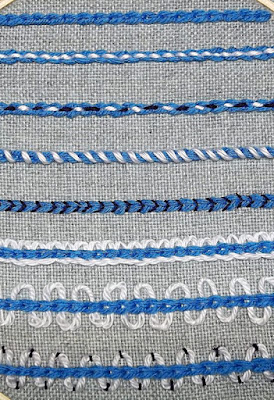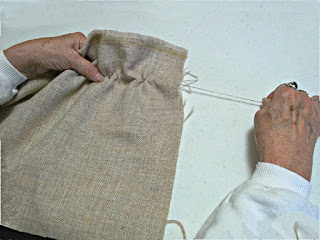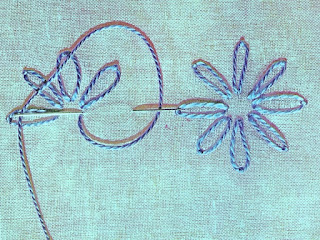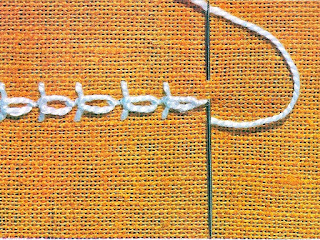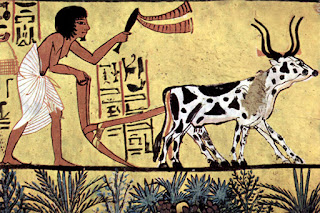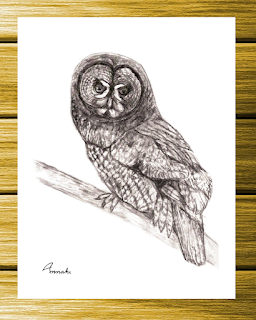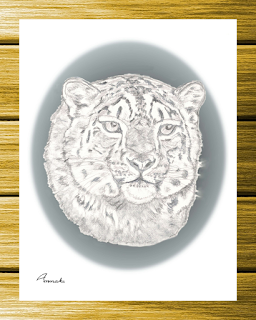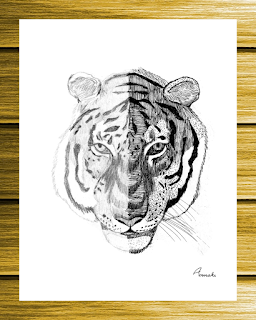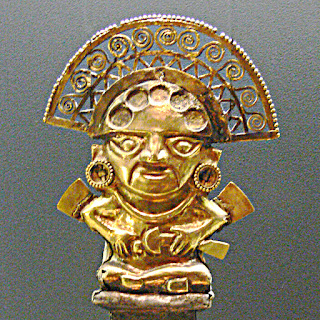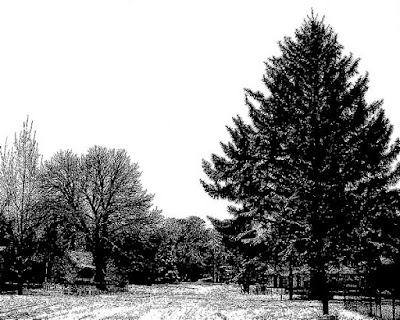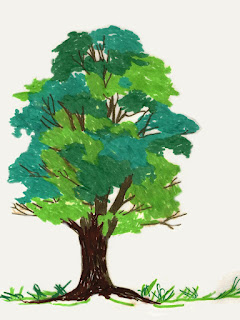 |
| Pencil sketch by Annake |
Welcome to our 168th post, and the beginning of this blog’s 8th year. While it does not seem that long since I talked Annake into doing this blog, things have really changed in the world, even our remote little piece of it. And we’ve changed, too, with different wants, needs, and capabilities than we had when we began.
So, we have decided to emphasize three areas in the coming year in this blog: first, art forms and techniques which have fallen out of fashion and could be forgotten; second, using art to support causes that are important to us, like promoting women in art and preserving endangered wildlife; and finally, presenting you — our readers — with more tools and techniques which can be used in a variety of forms and styles, so you can better make the art you want and make it uniquely yours.
Below are some of the things we've been thinking about.
J.D.: Roots are the beginnings of things, the first attempts to satisfy the most basic needs. When a seed germinates, the first thing to emerge is the root, seeking immediate sustenance and a hold on its place in its environment. Humans, have much the same basic survival needs, like food, protection from the elements, safety from predators. But just beyond these immediate needs, there seems to be a strong need to express one's self. In even the mot primitive societies, people use whatever is at hand to decorate themselves, their possessions, and their immediate surroundings. These decorations are very individualistic — a way to say, "This is me!"
ANNAKE: I'm sometimes asked why I discuss the history of an art form in my articles, or why I trace the changes in it over a long period of years. I simply believe that knowing something about the origins of a genre will help you understand its processes better. It certainly does that for me. I also like to know how it has progressed over time and how it adapted to the tastes. economy and customs of different historic periods. That helps me to design activities that relate to the present, whether it be the raw materials or tools that I use, new techniques, themes that are currently popular or appropriate, or ways to use the principles of the genre in a totally different art form.
Much of the history of these technologies (and, yes, that is exactly what they are) has been lost in time because the materials used were bio-degradable and were only preserved under unusual circumstances, like the tombs of the Egyptian Pharaohs. But enough survived to make inroads in the mystery, and, after trading became widespread, it is possible to trace the development of certain techniques and even styles.
J.D.: Pigments wash off, flake off, fade in the weather. Feathers, hides, wood — even bone — weather and decay over time. Still, the more we find in archaeological digs, the further back in time we push decorative processes. This is certainly true of the fiber arts, which have been the main focus of this blog. Until just over a century ago, textile fibers were one of the most fragile and transient materials in common use. Specimens of clothing, fabric, and needlework from as recently as 1,000 years ago are very rare, and most of what we know about fiber arts before about 2,000 years ago comes from implements and depictions in other media like painting.
ANNAKE: Embroidery, like other techniques, evolves over time. It evolved from sewing, which has been around for at least 30,000 years. This was the sewing which made survival in the cold possible. Also sail-making, which made travel along the ancient rivers like the Tigris, Euphrates, and Nile possible and led to sailing on seas and oceans. Tent-making, which allowed nomadic tribes to venture into and across unknown territories, also contributed. The tent stitch used in needlepoint is a tent-maker's and sail-maker's stitch. Basket-making and weaving contributed patterns.
For much of recorded history, art forms, including the fiber arts, were limited to possession by churches and other religious institutions, royalty, and a few people who who had become wealthy through banking and trade. Now they are within the reach of the general public. Partly this is due to the proliferation of modern materials. For example, it it is not only possible to embroider with silk, linen, or wool, but also with rayon, nylon, cotton, acrylics, metallics, even bamboo.
J.D.: Leaves are the part of the plant where most of the work takes place. Their most important job is to provide the fuel which lets the plant grow, survive, and reproduce. They take in oxygen to burn for fuel, and get rid of the exhaust fumes. They have different sizes and colors, different shapes, always variations in small details. Leaves are the first place a plant experiments and adjusts itself to get the most out of its environment. Leaves are the first place where changes in the plant's health or challenges from a changing environment appear. They are the first place where extreme or unusual temperature changes, changes in soil chemistry or the amount of light, and attacks by parasites or diseases show up. Plants have evolved methods to counteract environmental crises; these show as changes in the leaves.
ANNAKE: I tend to think of kinds of art as being like the branches and leaves of a tree — some growing out from the same cluster, but differing slightly from each other; others supporting old, traditional pursuits, then suddenly sending out a new and atypical branch or two,
Art has moved further toward abstraction in recent years, going first through a period of minimalism. Today, however, it is trending toward more color, more contrast, the juxtaposition of shapes, and the emphasis on surface textures. Needle arts and other art forms that we feature lend themselves to these trends. For example, I recently did an article on Assisi work. In this period of marches and demonstrations, the technique — whether or not it is used in needlework — lends itself greatly to signs and slogans, as well as to more traditional subject matter.
J.D.: If you think of the forms and styles of needle arts that Annake has explored in this blog as leaves, you can often see results of changes in economic and social environments. The rise of the middle class in Europe resulted in needlepoint as a less expensive substitute for woven tapestry. The Muslim conquest of Spain resulted in geometric patterns that became blackwork, which English royalty enthusiastically embraced. Changes in trade flow with East Asia influenced the availability of silk, popularity of different styles of garments, and the needlework that decorated them. The development of coal tar dyes in the 19th Century and synthetic fibers in the 20th have revolutionized how we approach fiber arts.
ANNAKE: We have learned that hands-on activities are very important in improving learning abilities. Having spent half a century as an educator, I learned early to introduce creative activities into my curriculum whether I was dealing with kindergarten children or college students, G.I.'s, Seniors, or people needing physical or occupational therapy. That is a pretty large portion of society. I believe we should encourage creative practices whenever we can.
J.D.: The stem is the part of a plant that provides the structural integrity which holds the leaves up where they can get the sunlight they need to accomplish their tasks, and that maintains the link between the roots and the leaves. Unlike leaves, stems are seldom disposable: as the cells of the stem age, or even die, they remain incorporated in the growing structure which supports all the other above-ground parts and functions of the plant. You can read the entire life history of a tree in the rings of its trunk.
S.T.E.M. is also a very "in vogue" acronym in the U.S., standing for "Science, Technology, Engineering, and Mathematics"; areas of study Americans feel are essential for young people to be well-versed in to obtain good jobs and to support the massive and complex economy we depend upon for security, comfort, and the continuation of the society we are used to.
"Science" does not require armies of lab-coated nerds in laboratories full of glistening machinery and odd-shaped bottles full of unpronounceable contents. "Science" is what happened when one of our paleolithic ancestors noticed that herds of edible creatures seemed to be at a particular spot when the sun was at a very specific place in the sky, and determined to be hunting with a spear at that spot the next time that happened.
"Technology" is not the latest electronic gadget. It is as simple as learning that, when you strike two particular kinds of rock together in a certain way, one of them will flake off with a very useful, extremely sharp edge.
"Engineering"' does not need to feature pages (or screens) of arcane symbols, numbers, and calculations. It can be as basic as figuring how best to attach that sharp rock you just cut to a stick with some resin so that it will stay attached and you won't cut your fingers with it.
"Mathematics" was what your thousand-times great-grandfather used to figure how many spearheads he needed to flake to replace the ones lost or broken during the last hunt. I' m not going to suggest that what most people think of when they see or hear "S.T.EM." is not important and worthwhile to invest time, effort, and money into its study. What I do want to say is that S.T.E.M. is a basic set of problem-solving tools, mindsets, disciplines, and points-of-view that people have used to survive and prosper since the beginning of human consciousness. All those steps in between, from sharpening stones to making smart phones, are a history of how people used these disciplines; and they are still with us, like the growth rings in the tree trunk.
ANNAKE: And you should be using those disciplines every day, even in something as "old-fashioned" as needlework. You don't need to invent anything. Just learn what's available and choose the best options for what you want to make. Do you need a sharp needle or a blunt one? Long or short? Large eye or small eye? Yarn or floss? Fabric or canvas? Colors? It is as easy as that. The result of your decisions will be something uniquely yours that would have never existed if you hadn't created it. (On the other hand, if you find a way to use existing tools and materials in a novel way..... Congratulations! You have just invented a new technology!)
J.D.: Engineering is often a matter of improvisation, like using a picture frame in place of a large embroidery hoop that you don't have. Or it might be a matter of using a common tool for a purpose it was never intended to fill, but which fits your situation well. Design a tool that works well for you, but isn't on the market. You're an engineer!
It is almost impossible to avoid math while doing needlework, even if you are only counting threads in fabric or squares in canvas, figuring how much yarn it will take to crochet an afghan, or plotting a graph-paper pattern.
ANNAKE: I would like to challenge all you readers to make something original with your hands. (Hey, J.D., is it okay if I dare them to do it?)
J.D.:
It works for me.
So, we have decided to emphasize three areas in the coming year in this blog: first, art forms and techniques which have fallen out of fashion and could be forgotten; second, using art to support causes that are important to us, like promoting women in art and preserving endangered wildlife; and finally, presenting you — our readers — with more tools and techniques which can be used in a variety of forms and styles, so you can better make the art you want and make it uniquely yours.
Below are some of the things we've been thinking about.
J.D., Annake's Garden Gnome
 |
| Bulls: 1) Lascaux cave, 15,000 BCE 2) Egyptian tomb, 1000 BCE 3) Goya lithograph, 1825 |
Roots
J.D.: Roots are the beginnings of things, the first attempts to satisfy the most basic needs. When a seed germinates, the first thing to emerge is the root, seeking immediate sustenance and a hold on its place in its environment. Humans, have much the same basic survival needs, like food, protection from the elements, safety from predators. But just beyond these immediate needs, there seems to be a strong need to express one's self. In even the mot primitive societies, people use whatever is at hand to decorate themselves, their possessions, and their immediate surroundings. These decorations are very individualistic — a way to say, "This is me!"
ANNAKE: I'm sometimes asked why I discuss the history of an art form in my articles, or why I trace the changes in it over a long period of years. I simply believe that knowing something about the origins of a genre will help you understand its processes better. It certainly does that for me. I also like to know how it has progressed over time and how it adapted to the tastes. economy and customs of different historic periods. That helps me to design activities that relate to the present, whether it be the raw materials or tools that I use, new techniques, themes that are currently popular or appropriate, or ways to use the principles of the genre in a totally different art form.
Much of the history of these technologies (and, yes, that is exactly what they are) has been lost in time because the materials used were bio-degradable and were only preserved under unusual circumstances, like the tombs of the Egyptian Pharaohs. But enough survived to make inroads in the mystery, and, after trading became widespread, it is possible to trace the development of certain techniques and even styles.
J.D.: Pigments wash off, flake off, fade in the weather. Feathers, hides, wood — even bone — weather and decay over time. Still, the more we find in archaeological digs, the further back in time we push decorative processes. This is certainly true of the fiber arts, which have been the main focus of this blog. Until just over a century ago, textile fibers were one of the most fragile and transient materials in common use. Specimens of clothing, fabric, and needlework from as recently as 1,000 years ago are very rare, and most of what we know about fiber arts before about 2,000 years ago comes from implements and depictions in other media like painting.
ANNAKE: Embroidery, like other techniques, evolves over time. It evolved from sewing, which has been around for at least 30,000 years. This was the sewing which made survival in the cold possible. Also sail-making, which made travel along the ancient rivers like the Tigris, Euphrates, and Nile possible and led to sailing on seas and oceans. Tent-making, which allowed nomadic tribes to venture into and across unknown territories, also contributed. The tent stitch used in needlepoint is a tent-maker's and sail-maker's stitch. Basket-making and weaving contributed patterns.
For much of recorded history, art forms, including the fiber arts, were limited to possession by churches and other religious institutions, royalty, and a few people who who had become wealthy through banking and trade. Now they are within the reach of the general public. Partly this is due to the proliferation of modern materials. For example, it it is not only possible to embroider with silk, linen, or wool, but also with rayon, nylon, cotton, acrylics, metallics, even bamboo.
 |
| 1) Folk art, traditional materials and methods 2) Traditional needlepoint, high tech design aids 3) Needlepoint, acrylic yarn on plastic canvas (modern materials) |
Leaves
J.D.: Leaves are the part of the plant where most of the work takes place. Their most important job is to provide the fuel which lets the plant grow, survive, and reproduce. They take in oxygen to burn for fuel, and get rid of the exhaust fumes. They have different sizes and colors, different shapes, always variations in small details. Leaves are the first place a plant experiments and adjusts itself to get the most out of its environment. Leaves are the first place where changes in the plant's health or challenges from a changing environment appear. They are the first place where extreme or unusual temperature changes, changes in soil chemistry or the amount of light, and attacks by parasites or diseases show up. Plants have evolved methods to counteract environmental crises; these show as changes in the leaves.
ANNAKE: I tend to think of kinds of art as being like the branches and leaves of a tree — some growing out from the same cluster, but differing slightly from each other; others supporting old, traditional pursuits, then suddenly sending out a new and atypical branch or two,
Art has moved further toward abstraction in recent years, going first through a period of minimalism. Today, however, it is trending toward more color, more contrast, the juxtaposition of shapes, and the emphasis on surface textures. Needle arts and other art forms that we feature lend themselves to these trends. For example, I recently did an article on Assisi work. In this period of marches and demonstrations, the technique — whether or not it is used in needlework — lends itself greatly to signs and slogans, as well as to more traditional subject matter.
J.D.: If you think of the forms and styles of needle arts that Annake has explored in this blog as leaves, you can often see results of changes in economic and social environments. The rise of the middle class in Europe resulted in needlepoint as a less expensive substitute for woven tapestry. The Muslim conquest of Spain resulted in geometric patterns that became blackwork, which English royalty enthusiastically embraced. Changes in trade flow with East Asia influenced the availability of silk, popularity of different styles of garments, and the needlework that decorated them. The development of coal tar dyes in the 19th Century and synthetic fibers in the 20th have revolutionized how we approach fiber arts.
ANNAKE: We have learned that hands-on activities are very important in improving learning abilities. Having spent half a century as an educator, I learned early to introduce creative activities into my curriculum whether I was dealing with kindergarten children or college students, G.I.'s, Seniors, or people needing physical or occupational therapy. That is a pretty large portion of society. I believe we should encourage creative practices whenever we can.
 |
| 1) Color theory 2) Annake at the computer 3) Re-engineered kitchen cart 4) Designing a six-way needlepoint |
S.T.E.M.
J.D.: The stem is the part of a plant that provides the structural integrity which holds the leaves up where they can get the sunlight they need to accomplish their tasks, and that maintains the link between the roots and the leaves. Unlike leaves, stems are seldom disposable: as the cells of the stem age, or even die, they remain incorporated in the growing structure which supports all the other above-ground parts and functions of the plant. You can read the entire life history of a tree in the rings of its trunk.
S.T.E.M. is also a very "in vogue" acronym in the U.S., standing for "Science, Technology, Engineering, and Mathematics"; areas of study Americans feel are essential for young people to be well-versed in to obtain good jobs and to support the massive and complex economy we depend upon for security, comfort, and the continuation of the society we are used to.
"Science" does not require armies of lab-coated nerds in laboratories full of glistening machinery and odd-shaped bottles full of unpronounceable contents. "Science" is what happened when one of our paleolithic ancestors noticed that herds of edible creatures seemed to be at a particular spot when the sun was at a very specific place in the sky, and determined to be hunting with a spear at that spot the next time that happened.
"Technology" is not the latest electronic gadget. It is as simple as learning that, when you strike two particular kinds of rock together in a certain way, one of them will flake off with a very useful, extremely sharp edge.
"Engineering"' does not need to feature pages (or screens) of arcane symbols, numbers, and calculations. It can be as basic as figuring how best to attach that sharp rock you just cut to a stick with some resin so that it will stay attached and you won't cut your fingers with it.
"Mathematics" was what your thousand-times great-grandfather used to figure how many spearheads he needed to flake to replace the ones lost or broken during the last hunt. I' m not going to suggest that what most people think of when they see or hear "S.T.EM." is not important and worthwhile to invest time, effort, and money into its study. What I do want to say is that S.T.E.M. is a basic set of problem-solving tools, mindsets, disciplines, and points-of-view that people have used to survive and prosper since the beginning of human consciousness. All those steps in between, from sharpening stones to making smart phones, are a history of how people used these disciplines; and they are still with us, like the growth rings in the tree trunk.
ANNAKE: And you should be using those disciplines every day, even in something as "old-fashioned" as needlework. You don't need to invent anything. Just learn what's available and choose the best options for what you want to make. Do you need a sharp needle or a blunt one? Long or short? Large eye or small eye? Yarn or floss? Fabric or canvas? Colors? It is as easy as that. The result of your decisions will be something uniquely yours that would have never existed if you hadn't created it. (On the other hand, if you find a way to use existing tools and materials in a novel way..... Congratulations! You have just invented a new technology!)
J.D.: Engineering is often a matter of improvisation, like using a picture frame in place of a large embroidery hoop that you don't have. Or it might be a matter of using a common tool for a purpose it was never intended to fill, but which fits your situation well. Design a tool that works well for you, but isn't on the market. You're an engineer!
It is almost impossible to avoid math while doing needlework, even if you are only counting threads in fabric or squares in canvas, figuring how much yarn it will take to crochet an afghan, or plotting a graph-paper pattern.
ANNAKE: I would like to challenge all you readers to make something original with your hands. (Hey, J.D., is it okay if I dare them to do it?)
J.D.:
It works for me.
 |
| What will you make? |
 This post by Annake's Garden is licensed under a Creative Commons Attribution-NonCommercial-ShareAlike 3.0 Unported License.
This post by Annake's Garden is licensed under a Creative Commons Attribution-NonCommercial-ShareAlike 3.0 Unported License.


